WGC Hall Of Famers
Cypress Lake Golf Club is incredibly fortunate and incredibly proud
to have had, among its earliest members, three absolutely
legendary figures in the history of American golf.
Hall Of Famers At Cypress Lake
Cypress Lake Golf Club is incredibly fortunate and incredibly proud to have had, among its earliest members, three absolutely legendary figures in the history of American golf. Each one of these individuals exudes excellence, and together they form a triumvirate of true greatness.
First up is none other than the one and only Patty Berg, whose name has become synonymous with excellence on the links. An absolute trailblazer in her sport, Berg inspired countless others to reach for their dreams and seek out success.
Next, we have Gene Sarazen, whose contributions to the game of golf are simply too numerous to mention here. His influence can still be seen in the way that the sport is played and viewed today.
Lastly, we have the incomparable Herb Graffis, whose unparalleled skill with the pen brought golf into homes and hearts across the nation. Together, these three heroes have forever cemented their place in the annals of American golf history.
All three made enduring contributions to the sport of golf, and all have been inducted into the World Golf Hall of Fame.


Few if any other clubs can lay claims to having three Hall of Fame members at the same time. When the first stock was issued for the club in November, 1959, all three were numbered among the recipients.
Patricia “Patty” Berg (1918 – 2006)
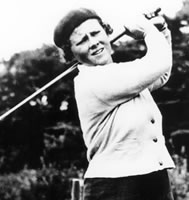 She was the first United States Women’s Open Champion, first president of the Ladies Professional Golf Association, and one of golf’s greatest ambassadors. Her 15 major titles remain the all-time record for most major wins by a female golfer.
She was the first United States Women’s Open Champion, first president of the Ladies Professional Golf Association, and one of golf’s greatest ambassadors. Her 15 major titles remain the all-time record for most major wins by a female golfer.
She was born in Minneapolis in 1918, and began playing golf at the age of 13. She won her first title, the 1934 Minneapolis City Championship three years later, and went on to win 29 amateur tournaments in seven years, including the 1938 U.S. Women’s Amateur Championship. She turned professional in 1940 and won the Western Open in 1941 and then joined the Marine Reserves (1942-45) as World War II commanded our country’s attention.
In 1946, she joined the Women’s Professional Golfers Association tour and won four titles, including the U.S. Women’s Open. In 1949, she and Babe Zaharias formed the Ladies Professional Golf Association. She served as its first president, and fostered its growth with her active tournament schedule.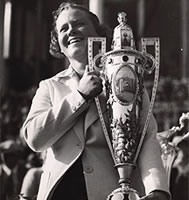 Patty enjoyed 55 victories between 1948 and 1962. She was a charter inductee into the Women’s Golf Hall of Fame (now the LPGA Hall of Fame) in 1951. In 1963, she was voted the Bob Jones Award, the highest honor given by the USGA in recognition of distinguished sportsmanship in golf. She was also one of the first inductees into the World Golf Hall of Fame in 1974. The LPGA honors Berg through its Patty Berg Award for diplomacy, sportsmanship, goodwill and contributions to the game. The LPGA established the Patty Berg Award in 1978.
Patty enjoyed 55 victories between 1948 and 1962. She was a charter inductee into the Women’s Golf Hall of Fame (now the LPGA Hall of Fame) in 1951. In 1963, she was voted the Bob Jones Award, the highest honor given by the USGA in recognition of distinguished sportsmanship in golf. She was also one of the first inductees into the World Golf Hall of Fame in 1974. The LPGA honors Berg through its Patty Berg Award for diplomacy, sportsmanship, goodwill and contributions to the game. The LPGA established the Patty Berg Award in 1978.
Patty remained an active member at Cypress Lake until her passing at the age of 88 on September 10, 2006, participating in social functions, and encouraging the women’s golf leagues. She was frequently seen on the practice tee. Cypress Lake hosts two tournaments that bear Patty’s name. The Patty Berg Pro- Am is an annual women’s tournament that benefits junior golf. In her later years, Berg teamed up with PGA Tour player Nolan Henke to establish the Nolan Henke/Patty Berg Junior Masters to promote the development of young players. Patty always shared a special interest in the Vera Berg tournament, which is named for her mother, who was also a member of Cypress Lake, and a winner of the WGA championship.
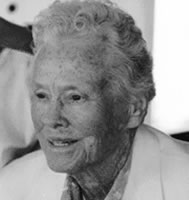 Patty Berg racked up one of the finest amateur and professional records in the game. Although she was one of the most skilled players in history, her larger than life personality nearly overshadowed her talent and she was much in demand for public appearances long after she competed in her last tournament in 1980. Berg received the 1986 Old Tom Morris Award from the Golf Course Superintendents Association of America, the organization’s highest honor. The largest single exhibit of Patty’s trophies and memorabilia are displayed in the Cypress Lake clubhouse lobby. Patty placed this collection on permanent loan to the Club so that her legacy and contribution to the game of golf would forever be an inspiration to us all.
Patty Berg racked up one of the finest amateur and professional records in the game. Although she was one of the most skilled players in history, her larger than life personality nearly overshadowed her talent and she was much in demand for public appearances long after she competed in her last tournament in 1980. Berg received the 1986 Old Tom Morris Award from the Golf Course Superintendents Association of America, the organization’s highest honor. The largest single exhibit of Patty’s trophies and memorabilia are displayed in the Cypress Lake clubhouse lobby. Patty placed this collection on permanent loan to the Club so that her legacy and contribution to the game of golf would forever be an inspiration to us all.
Visit her page
Herb Graffis (1893 – 1987)
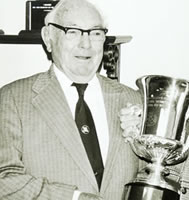 The rapid growth of golf’s popularity owes much to its brilliant and charismatic star players. Credit is due, as well, to its Herb Graffis enthusiasts among sports journalists. Herb Graffis didn’t miss much when he sat down at his typewriter. Golfing was created, in Graffis’ words, “because the manufacturers couldn’t afford to spend much on ad space in the (Saturday Evening) Post or Colliers, but they wanted to do something that would get in the hands of a select list of golfers.” His generation of great golf writers included Grantland Rice, Bernard Darwin, Ring Henry Longhurst, Herbert Warren Wind and Charles Price, yet his greatest contributions to the game came not from what he wrote, but through the conception of his ideas.
The rapid growth of golf’s popularity owes much to its brilliant and charismatic star players. Credit is due, as well, to its Herb Graffis enthusiasts among sports journalists. Herb Graffis didn’t miss much when he sat down at his typewriter. Golfing was created, in Graffis’ words, “because the manufacturers couldn’t afford to spend much on ad space in the (Saturday Evening) Post or Colliers, but they wanted to do something that would get in the hands of a select list of golfers.” His generation of great golf writers included Grantland Rice, Bernard Darwin, Ring Henry Longhurst, Herbert Warren Wind and Charles Price, yet his greatest contributions to the game came not from what he wrote, but through the conception of his ideas.
Graffis launched a number of golf publications: Chicago Golfer (1923); Golfdom (1927), a trade magazine; and Golfing (1933), a general interest monthly. Graffis co-wrote a book How to Play Your Best Golf All the Time (1952) with Tommy Armour (1894 – 1968), a golf legend in his own right. The book became a best seller and for many years was the biggest-selling book ever authored on the game of golf.
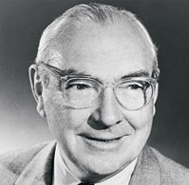 Graffis, along with his brother Joe, founded the National Golf Foundation, and was a founding member of the Golf Writers Association of America. Robert Rickey, a former NGF president said of Graffis, “Never has a person in the history of American golf contributed so much to the game’s overall growth and health. His greatest talent was to get people to do what was in the game’s best interest – and convince them it was their idea.”
Graffis, along with his brother Joe, founded the National Golf Foundation, and was a founding member of the Golf Writers Association of America. Robert Rickey, a former NGF president said of Graffis, “Never has a person in the history of American golf contributed so much to the game’s overall growth and health. His greatest talent was to get people to do what was in the game’s best interest – and convince them it was their idea.”
Graffis was a member of Cypress Lake Golf Club until his death in 1987. He was fond of saying that “a golfer only needs seven clubs; the rest were developed to increase the revenues of golf manufacturers.” Graffis’ spirit lives on at Cypress Lake. In his honor, the Club holds an annual Pro-Am event in which a player’s weaponry is restricted to seven clubs – and their skill level, of course.
Visit his page
Gene Sarazen (1902 – 1999)
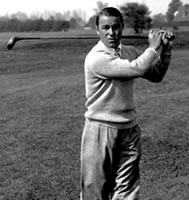 He once declared “I don’t care what you say about me. Just spell the name right.” Gene Sarazen was the first golfer to win the Gene Sarazen career grand slam and was among the first class of inductees into the World Golf Hall of Fame in 1974. He was born Eugene Saraceni, and his playing days were behind him when he joined Cypress Lake Golf Club.
He once declared “I don’t care what you say about me. Just spell the name right.” Gene Sarazen was the first golfer to win the Gene Sarazen career grand slam and was among the first class of inductees into the World Golf Hall of Fame in 1974. He was born Eugene Saraceni, and his playing days were behind him when he joined Cypress Lake Golf Club.
As much as he’s known for his accomplishments on the course, Sarazen is also famous for off-course accomplishments. Sarazen was a poor sand bunker player because of the thin-bladed niblick (9-iron) that was used in the day. Looking for an edge, Sarazen devised an angled flange for the back of the niblick so the club wouldn’t dig into the sand so sharply. According to the World Golf Hall of Fame, Sarazen invented the modern sand wedge. His idea came in 1931 after he noticed how an airplane’s tail adjusted during flight while receiving flying instruction from Howard Hughes. Sarazen used the sand wedge for the first time to capture the 1932 British Open. The wedge was revolutionary in its impact on the playing of golf. Sarazen’s innovations also included a weighted practice club. He argued unsuccessfully for enlarging the hole size, believing more putts made would increase the popularity of the sport.
Sarazen turned pro in 1920, while still a teenager, and started winning majors – the 1922 U.S. Open and PGA – at the age of 20. He won three majors in 1922-23, and four more from 1932-35. Sarazen always had a knack for the spectacular. His “Shot Heard ‘Round the World” at the 1935 Masters – a final-round hole-out from 225 yards with a 4-wood for a double-eagle on No. 15 – is one 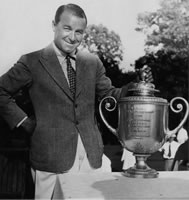 of the most famous shots in golf history. It helped Sarazen get into a playoff with Craig Wood, which Sarazen won to claim his career grand slam. The spectacular shot is often credited with getting the Masters on its way as a major championship.
of the most famous shots in golf history. It helped Sarazen get into a playoff with Craig Wood, which Sarazen won to claim his career grand slam. The spectacular shot is often credited with getting the Masters on its way as a major championship.
In the 1960s, Sarazen teamed with Jimmy Demaret to form a colorful commentary team for broadcasts of “Shell’s Wonderful World of Golf.”
Sarazen was an excellent golfer well after his PGA Tour career ended, winning the PGA Seniors Championship twice. During his farewell appearance in 1973, Sarazen scored a hole-in-one in the British Open at age 71. It came on the famed “Postage Stamp” hole at Royal Troon. Sarazen left the game of golf with flair, just as he had come in.
At the time of his death in 1999, Sarazen was the oldest and longest-serving member of the PGA of America.
Visit his page
